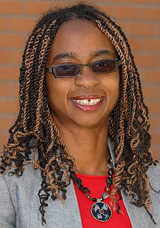| Presumed Incompetent: The Intersections of Race and Class for Women in Academia Utah State University Press, 2012 |
A Latino faculty member just received news that his daughter has been accepted to Harvard. He is so excited, he tells a fellow colleague. The colleague replies: “That’s great. I guess Harvard has special programs for kids like yours.”
A Chicana faculty member, who does not have tenure yet, points out that other faculty in the English department are not including minority literature in their courses. She is told: “That is why we hired you.” She decides to refrain from future comments.
At an administrative meeting, two presentations occur: one concerns the hiring of women. Diversity is in the title but the hiring of minorities or strategies in changing campus culture regarding race and class is not part of the conversation. The second presentation discusses projected percentages revealing that by 2020, there will be a 19.4% jump in Latinos graduating from high school. There is no discussion in making connections regarding both presentations: the growing Latino population in the classroom and exploring cultural, racial, or class bias regarding hiring in predominantly white institutions.
One April afternoon, a Chicana undergraduate is at a gathering on campus. She is a junior and contemplating graduate school. This is what she tells a faculty administrator who is at the reception for undergraduate students. The administrator replies: “You probably won’t get in. We give you people scholarships at the undergraduate level, but don’t expect them at the graduate level.”
These four examples are not unusual. They happen every day at universities throughout the United States. To many, it is difficult to believe that in 2012, we are far from any kind of "post-racial society."
Enter Gabriella Gutiérrez y Muhs (Latin American Studies Director at Seattle University), Yolanda Flores Niemann (Senior Vice Provost at the University of North Texas), Carmen G. González (Professor of law at Seattle University School of Law), and Angela P. Harris (Professor of Law at the University of California, Davis School of Law). These four women of color have spent years collecting data and testimonies (quantitative and qualitative) from women of color in academia across the country.
 |
| Gabriella Gutiérrez y Muhs |
Presumed Incompetent: The Intersections of Race and Class for Women in Academia is a 570-page “must read” for everyone in and outside of academia. In the Introduction, Harris and González write: “This book demonstrates . . . that the women of color who have managed to enter the rarified halls of academe as full-time faculty find themselves in a peculiar situation. Despite their undeniable privilege, women of color faculty members are entrenched in Byzantine patterns of race, gender, and class hierarchy that confound popular narratives about meritocracy. Far from being above the fray, faculty at institutions of higher education are immersed in the daunting inequities and painful struggles taking place throughout an increasingly multicultural America.
 |
| Yolanda Flores Niemann |
For many women of color on college and university campuses, the problems begin with numerical representations. While the nation’s student population is becoming increasingly diverse, the overwhelming majority of full-time faculty positions continue to be filled by white men and women. From 1997 to 2007, for example, the percentage of students of color enrolled in US colleges and universities climbed from 25 to 30 percent (Ryu 2010). However, the percentage of full-time faculty positions held by people of color increased only slightly—from 13 percent in 1997 to 17 percent in 2007 (Ryu 2010). Women of color, in particular, continue to be underrepresented . . . The narratives collected in this volume reveal that not only the demographics but the culture of academia is distinctly white, heterosexual, and middle- and upper-middle-class. Thos who differ from the norm find themselves, to a greater or lesser degree, “presumed incompetent” by students, colleagues, and administrators.” (2-3)
To combine empirical/quantitative data with qualitative research (the testimonies which frame and fully develop and “bridge the epistemological gap that frequently appears between the lives of people with a particular privilege and those who lack that privilege”) makes this a brilliant text, a must-read for all academics at every level. And for faculty of color, there are lessons to be learned such as recognizing how easy it can be to re-inscribe the hierarchies of “privilege” which replicates the abuse cycle both within oneself and toward other faculty of color.
 |
| Carmen G. González |
These chapters include illustrations of some of the most demeaning and injurious behaviors that occur daily in academia. But this book is not about simply revealing what faculties of color endure. It is also about their resilience and survival tactics.
The text also provides the kind of helpful advice I wish I had been given during my undergraduate and graduate school years. Chapter 30, for example, is entitled “Lessons From the Experiences of Women of Color Working in Academia.” In one section, #13 instructs “Do Not Define white Women as the De Facto Norm for All Women by Using the Phrase, ‘Women and People of Color’ or ‘Women and Minorities.’” “Women of color are women; they are also people of color; they are also minorities. The use of the phrases “women and people of color” and “women and minorities” makes women of color invisible while defining white women as the de facto norm. The use of these phrases minimizes the intersectional realities that both link and separate white women, men of color, and women of color . . . “ (459).
 |
| Angela P. Harris |
This section relates to the presentation on hiring “women” at the beginning of this blog. It also connects with our own tendency (due to the way society shapes narratives) to think generally in relation to people instead of specifically. Terms like “post racial” or “color blind” do not help but hinder any progress toward understanding the very nuanced or distinct issues among and between intersecting groups.
Gabriella Gutiérrez y Muh writes: “The essays presented here are about surviving and even thriving in what are often foreign and hostile environments, no matter what rank these working-class women and women of color have achieved. Most of the women represented in this collection have, in fact, soared, thrived, and succeeded with very few resources and courageously wanted to make the process of navigating the academic world democratically transparent, not only so that others might succeed but to reveal that other women who did or did not triumph in academia were part of some negative force that was national and existed in most institutions of higher learning, even in the twenty-first century.” (503)
Felicidades to the editors and the brave academics who have so generously and fearlessly offered their stories to this collection. Read this book! It is an important one. And if you are not an academic—it is important for you as well because it reflects what can happen in every workplace throughout the U.S. As well, if you are a parent, it will give you a glimpse into the school system, the kind of school mentality your son/daughter is attending.
Sending you, dear La Bloga readers a very good week! Abrazos!
3 Comments on What "Presumed Incompetent" Looks Like, last added: 12/11/2012
Display Comments
Add a Comment




I was asked to contribute an essay a long time ago for this book given my "horror stories"which continue to this day. I was grateful to have been asked but the editors imposed a page number and number of words at that time and someone who has experienced severe trauma and who never believe in "length" to show value, could not comply. Having said that, I take my hats off to these editors. I sent Gabriella a note when the book appeared but I am waiting for my signed gift copy for my archives at Bryn Mawr. This would be a MUST have there. As to the women of color statement, this is my humble take: disagree. There was a time when we had to define ourselves in these terms in order to INDEED be the counter NORM. It is an HONOR to call myself a woman of color.
I am back to add a clarification for my sister who wrote the review. We do not disagree; it was my bad that I did not understand your summary of their exposure. Not having read the book yet, I presented my point perhaps I shouldn't have. I fully understand your point now. Remember that I wrote either before "my marriage"to a book or after I married "a book" and one can be confused after or before marrying that which is "perfect bound" by love and not by ligatures.
Let us keep the conversation going and if you need me I am always here.
This is an amazing perspective that I had not yet really thought about. The short testimonials in this blog entry are very telling. I tell people in my circles that is up to each of us Latinos to make and be the change we want to see. If we raise ourselves up economically, we will earn power and respect in this country. Only then can we effect change in numbers and earn our rightful place as politicians, educators, and business and community leaders. I think it is happening, but it is slow like molasses. Thanks for sharing!
Adrian
http://a-lo-books.blogspot.com/